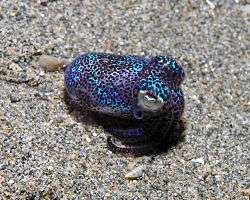Euprymna berryi
Euprymna berryi, commonly called hummingbird bobtail squid or Berry's bobtail squid among various other vernacular names, is a species of mollusc cephalopod in the family Sepiolidae.[3]
| Euprymna berryi | |
|---|---|
 | |
| Scientific classification | |
| Kingdom: | Animalia |
| Phylum: | Mollusca |
| Class: | Cephalopoda |
| Order: | Sepiida |
| Family: | Sepiolidae |
| Subfamily: | Sepiolinae |
| Genus: | Euprymna |
| Species: | E. berryi |
| Binomial name | |
| Euprymna berryi | |
Description
The hummingbird bobtail squid is a small sized sepia. Its size varies according to the sex; males are no bigger than 3 centimetres (1.2 in) while the female reaches 5 centimetres (2.0 in) length.[4] The global body aspect is compact and rounded. It possesses eight arms and two tentacles, a pair of small lateral fins on the posterior part of the mantle. The background color of the body is translucent with a large number of tiny dark chromatophores. Those later are widely distributed on all the body from arms, head, ventral and dorsal areas of the mantle, except the pair of lateral fins which only the border with the mantle has chromatophores. The external color of the sepia, as we see it, is like a blend of small dark, electric blue and green dots.
Distribution & habitat
The hummingbird bobtail squid is widespread throughout the tropical waters of the central Indo-Pacific area from the Indonesia to the Philippines.[5] Possible larger distribution that could reach Andaman Islands, the Sri Lanka and the western coast of India (some specimen were collected by scientists in 200-/2007).[6] Euprymna berryi has a benthic way of life, it likes sandy or fine sediments bottom in which it can easily bury itself in case of danger or to rest during day time.[7]
Biology
The hummingbird bobtail squid has a nocturnal activity, during daytime it usually stays buried in its preferred substrate. To hunt its prey at night, it uses a bioluminescent organ located in the gill cavity which just emits enough light not to reveal its silhouette to potential predators.[8] It feeds on mainly small benthic crustaceans.[9]
References
- Barratt, I.; Allcock, L. (2012). "Euprymna berryi". The IUCN Red List of Threatened Species. 2012: e.T162599A925343. doi:10.2305/IUCN.UK.2012-1.RLTS.T162599A925343.en. Downloaded on 11 February 2018.
- Julian Finn (2016). "Euprymna berryi Sasaki, 1929". World Register of Marine Species. Flanders Marine Institute. Retrieved 11 February 2018.
- http://fran.cornu.free.fr/affichage/affichage_nom.php?id_espece=1347
- Jereb & Roper, CEPHALOPODS OF THE WORLD, Roma, FAO, 2005 (ISBN 92-5-105383-9)
- Jereb & Roper, CEPHALOPODS OF THE WORLD, Roma, FAO, 2005 (ISBN 92-5-105383-9)
- Sujit Sundaram and Miriam Paul Sreeram, First record of sepiolid squid, Euprymna berryi Sasaki, 1929 from the west coast of India, Journal of the Marine Biological Association of India, 2008
- Norman, M.D. 2003. Cephalopods A World Guide. ConchBooks, Hackenheim, Germany.
- Young, Richard E. and Michael Vecchione. 1996. Euprymna Steenstrup, 1887. Version 01 January 1996 (under construction). http://tolweb.org/Euprymna/20036/1996.01.01
- Norman, M.D. 2003. Cephalopods A World Guide. ConchBooks, Hackenheim, Germany.
External links
- WORMS
- IUCN
- Photos of Euprymna berryi on Sealife Collection
| Wikimedia Commons has media related to Euprymna berryi. |
